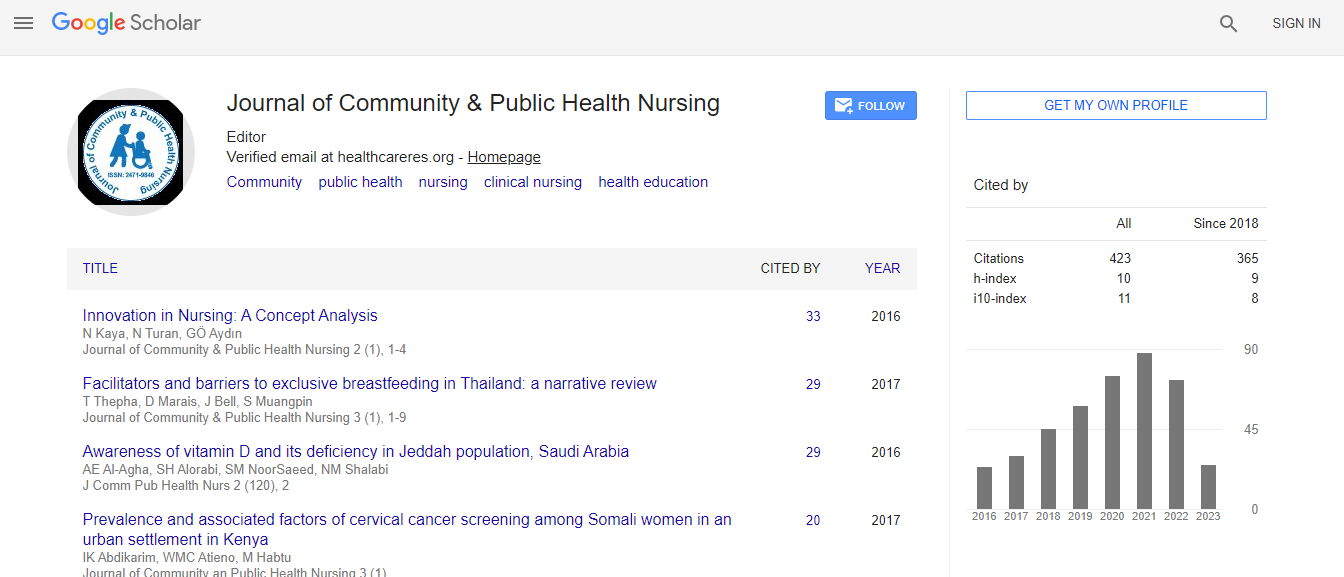Our Group organises 3000+ Global Conferenceseries Events every year across USA, Europe & Asia with support from 1000 more scientific Societies and Publishes 700+ Open Access Journals which contains over 50000 eminent personalities, reputed scientists as editorial board members.
Open Access Journals gaining more Readers and Citations
700 Journals and 15,000,000 Readers Each Journal is getting 25,000+ Readers
Google Scholar citation report
Citations : 739
Journal of Community & Public Health Nursing received 739 citations as per Google Scholar report
Journal of Community & Public Health Nursing peer review process verified at publons
Indexed In
- Google Scholar
- CiteFactor
- RefSeek
- Hamdard University
- EBSCO A-Z
- OCLC- WorldCat
- Publons
- Geneva Foundation for Medical Education and Research
- ICMJE
Useful Links
Recommended Journals
Related Subjects
Share This Page
Evaluating stress relief & stress effects with cognitive appraisal & perceived stress constructs
Joint Event on 21st World Congress on Registered Nurse and Nurse Practitioner Meeting & Nursing Education and Management
Dale Hilty
Mount Carmel Collage of Nursing, USA
Posters & Accepted Abstracts: J Comm Pub Health Nursing
Abstract
Researchers investigating cognitive appraisal and stress have focused on applying their findings to the creative arts, pregnancy, psychotherapy, academic, and sleep quality (Erschens et al., 2018; Martin, et al., 2018; Gonzalez-Ochoa, 2018; Wersebe et al., 2018; You-wei et al., 2018). The purpose of this educational intervention was to examine the effects of stress and stressors experienced by first semester Bachelor of Science of Nursing undergraduate students. One-hundred and eighty-four questionnaires were completed by the participants. The questionnaire consisted of two sections. First, the Brief College Student Hassle Scale (BCSHC) measured stressors (Ward & Hay, 2015) where participants rated their school and personal stress levels. Hypothesis 1: Determine whether the stress was a multidimensional construct for BSN students. Using SPSS 25, exploratory factor analysis principle axis (EFAPE) was used to select underlying factors and items (loadings >.50). Hypothesis 2: Determine if the coefficient alpha reliability coefficients for the EFAPE common factors had estimates greater than .70. Hypothesis 3: Determine the difference between participant ratings on questions measuring School Stress Level and Personal Stress Level. Using SPSS 25, the independent t-test would be to determine significant differences between the two groups. Hypothesis 4: Determine whether a mean difference in the answers measuring stress relieving techniques and the effects of stress was presented for the fore-mentioned groups. Using SPSS 25, chi-square test would evaluate this hypothesis. Results: Hypothesis 1: The EFAPE analysis found two factors (eigenvalues: 2.25, 1.71) based on the scree test accounting for 65.9% of the variance. Six of the BCSHC hassles/frustrations had factor loadings greater than .50. The common factors were named School (three questions) Personal (three questions). Hypothesis 2: Coefficient alpha estimates: School, .748 and Personal, .721. Hypothesis 3: Independent t-test found significant differences for the two groups (School, p=.004; Personal, p=.000). Hypothesis 4: Chi-square test was applied to relieving stress techniques and stress effects data, resulting significant findings (p=.012-.041).Biography
Dale M. Hilty, Associate Professor at the Mt. Carmel College of Nursing. He received his PhD in counseling psychology from the Department of Psychology at The Ohio State University. He has published studies in the areas of psychology, sociology, and religion. Between April 2017 and April 2018, his ten research teams published 55 posters at local, state, regional, national, and international nursing conferences.
E-mail: dhilty@mccn.edu

 Spanish
Spanish  Chinese
Chinese  Russian
Russian  German
German  French
French  Japanese
Japanese  Portuguese
Portuguese  Hindi
Hindi 
